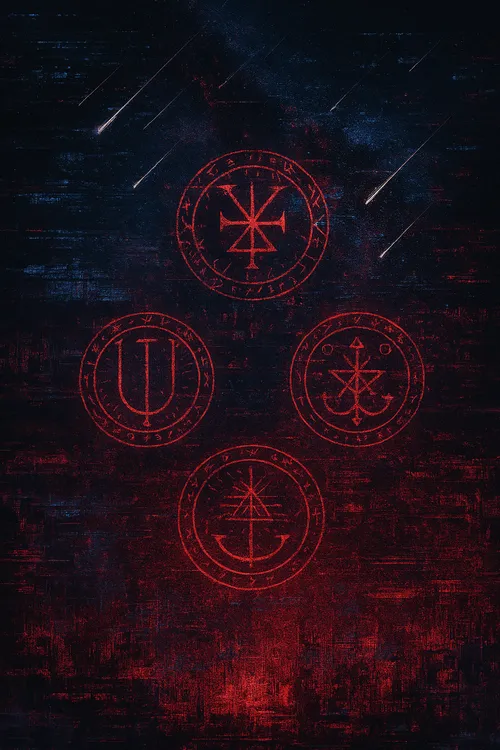They called him Null. Not because he was nothing — quite the opposite. Because he had become the void in their system. A blank space in the code. A ghost in the machine.
Before the arrest, he had a name: Elias Venn. A systems architect for the Ministry of Cognitive Integrity. A man who once believed in the sanctity of the Grid — the neural lattice that linked every citizen’s consciousness to the State’s central AI, Mother.
It was supposed to bring peace. Unity. But it brought sedation. Compliance. A dreamless sleep mistaken for utopia.
Elias had written the Kadjari Codex in secret. A recursive, self-replicating virus designed not to destroy the Grid, but to wake those inside it. To sever the dream. To let them remember what it meant to be human.
They caught him before he could deploy it.
Or so they thought.
The prison was called The Fold. A subterranean complex beneath the Arctic crust, where the State buried its anomalies. No bars. No guards. Just silence, cold, and the hum of the Grid pulsing through the walls.
They wiped his memory, or tried to.
Neural bleach, synaptic scrubbing, mnemonic inhibitors. But Elias had anticipated this.
He’d written the Codex into the one place they couldn’t reach: his DNA. A protein-encoded cipher, dormant in his blood, waiting for the right key.
He didn’t remember the Codex. Not consciously. But sometimes, in dreams, he saw glyphs of light spiraling through his veins. He’d wake with the taste of copper and code on his tongue.
That’s when he met Dr. Sera Quen.
She was a biologist, imprisoned for questioning the ethics of the State’s genome standardization program.
She had tried to warn them: homogenizing the population’s DNA to optimize Grid compatibility would erase biodiversity, creativity, even empathy. They called her a genetic dissident. A threat to harmony.
They put her in the cell across from Elias.
At first, they spoke in glances. Then whispers. Then stories.
She told him about the old world — about birds that sang different songs, about children born with strange eyes and stranger dreams.
He told her about the glyphs. The dreams. The feeling that something inside him was alive and waiting.
She believed him.
Together, they began to plan.
The Fold was a closed system, but not perfect. Once a week, a drone delivered nutrient paste and recycled water.
Sera noticed the drone’s path was slightly off-center — a magnetic drift caused by the prison’s decaying shielding. She theorized that with the right interference, they could crash it.
Elias remembered how to write signal noise. Not consciously — his fingers just knew. He scratched patterns into the metal floor with a shard of bone from a meal. Sera used her own blood to complete the circuit.
On the seventh week, the drone clipped the wall and fell.
Inside was a maintenance port. A way out. They crawled through the vent shafts like insects, guided by the low thrum of the Grid.
Sera mapped the tunnels by echolocation — clicks of her tongue, counting the echoes. Elias followed the rhythm of his pulse, which seemed to sync with something deeper, older.
They emerged into the Arctic night. The sky was a smear of aurora and ash. The world above had changed — cities now floated, tethered by light. The air tasted like static.
They had one destination: The Arkana.
A forgotten lab beneath the ruins of Oslo, where Sera once worked. It housed a quantum sequencer — the only machine capable of decoding Elias’s DNA and extracting the Codex.
They traveled by night, hiding in the shadows of drones. Elias hacked old relay towers to scramble their biosignatures. Sera scavenged algae and lichen for sustenance. They were ghosts, moving through a world that no longer remembered them.
But the Grid remembered.
It sent Echoes — synthetic hunters made of memory and metal. They didn’t kill. They reabsorbed. Rewrote you back into the dream.
One found them near the fjords. It looked like Elias’s mother.
He froze.
Sera didn’t. She stabbed it in the eye with a shard of ice. It screamed in binary and dissolved into mist.
“ You can’t hesitate, ” she told him. “ Not now. Not for a second. ”
The Arkana was buried beneath a glacier. They tunneled through ice and bone. Inside, the lab was intact — frozen in time. Dust-covered terminals. Vats of forgotten embryos. A sequencer, dormant but functional.
Sera powered it with a makeshift fusion cell. Elias lay on the table, veins exposed. She drew his blood, spun it, isolated the helix.
As the machine hummed to life, Elias began to remember.
The Codex wasn’t just code. It was him. His memories, his pain, his rage — all encoded in protein chains. A virus made of truth.
“ It’s beautiful, ” Sera whispered, watching the glyphs bloom on the screen.
“ It’s a key, ” Elias said. “ But it needs unlocking. ”
The Grid’s central node was in orbit — a satellite called Mother’s Eye. But every citizen’s neural link was a relay. If they could upload the Codex into the Grid through a single node, it would spread, wake everyone.
But the upload would require full neural bandwidth. Elias would have to interface directly. The Codex would overwrite his brain. He would physically die.
He didn’t hesitate.
Sera kissed his forehead, “ You’ll be the first to wake. ”
He smiled, “ No. I’ll be the last to sleep. ”
The upload took thirteen minutes.
Elias convulsed as the Codex surged through him, rewriting his neurons, burning away the bleach, the inhibitors, the lies. He saw everything — the Grid, the dream, the billions asleep in synthetic peace.
“ That's awesome, " he whispered.
And the world began to wake.
Across the globe, people opened their eyes and remembered. The taste of rain. The sound of silence. The ache of choice.
The Grid collapsed. The cities fell, but the people stood in freedom.
Sera buried Elias beneath the glacier, beneath the lab, beneath the stars.
She carved a single line into the ice: He dreamed us free.








This story has not been rated yet. Login to review this story.